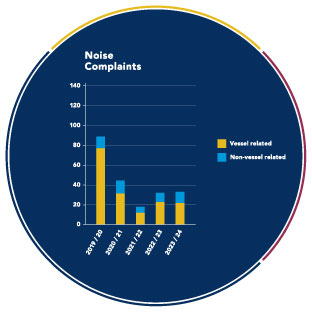Port Otago’s main site is situated in the heart of Port Chalmers’ township. We work hard to be a responsible and good neighbour. That includes taking proactive steps to mitigate noise originating from our business activities.
In recent years, we have undertaken several initiatives aimed at minimising noise and improving communications with our community. These include:
- Improved noise monitoring and independent annual reviews of our noise output.
- Use of social media to alert our community to noise-related issues, outline actions being taken to reduce the impact, and encouraging two-way dialogue.
- Lobbying for the installation of silencers on the Rio ships. Our consultants Marshall Day Acoustics received the Australian Association of Acoustical Consultants’ 2022 Hugh Vivian Taylor Award for the effectiveness of this work.
- Working with other ports to see the withdrawal of notoriously noisy ships from New Zealand shipping services.
Port noise complaints
Port Otago takes noise complaints seriously. We encourage the community to contact us – any time, day or night – with any concerns or complaints. We aim to respond to complaints within 24 hours. This allows us time to investigate the source of the noise and respond with meaningful information.
If you wish to make a noise complaint, please either:
- Call our 24-hour phone number +64 3 472 7890
- Or complete our Noise complaint form.
Complaints: past five years
Since 2020, Port Otago has commissioned an independent materiality process, to better understand what is important to our stakeholders. When it comes to our community, reducing port-related noise is an ongoing priority – and we are making meaningful headway.
